St Mary-le-Bow
St Mary-le-Bow (/lə ˈboʊ/) is an historic church rebuilt after the Great Fire of 1666 by Sir Christopher Wren in the City of London[2] on the main east–west thoroughfare, Cheapside. According to tradition a true Cockney must be born within earshot of the sound of Bow Bells (which refers to this church's bells rather than those of St Mary and Holy Trinity, Bow Road, in Bow, an outlying village until the 19th century).[3]
| St Mary-le-Bow | |
|---|---|
 Exterior of St Mary-le-Bow | |
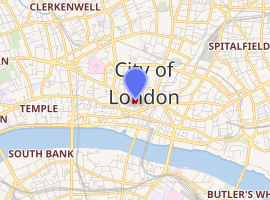
| |
| Location | London, EC2 |
| Country | England |
| Denomination | Church of England |
| Website | www |
| Architecture | |
| Heritage designation | Grade I[1] |
| Designated | 4 January 1950 |
| Architect(s) | Sir Christopher Wren |
| Style | Baroque |
| Years built | 1683 |
| Administration | |
| Parish | St Mary Le Bow Cheapside |
| Diocese | London |
| Clergy | |
| Vicar(s) | George Raymond Bush |
Bells
The sound of the bells of St Mary's is prominent in the story of Dick Whittington and His Cat,[4] in which the bells are credited with having persuaded him to turn back from Highgate and remain in London to become Lord Mayor.[5] The bells are also referred to in the nursery rhyme "Oranges and Lemons".
Details of the bells:
| Bell | Weight | Nominal | Note | Diameter | Cast | Founder |
|---|---|---|---|---|---|---|
| 1 | 5-3-21 | 1565.6 | G | 27.75" | 1956 | Mears & Stainbank |
| 2 | 5-3-10 | 1389.5 | F | 29.00" | 1956 | Mears & Stainbank |
| 3 | 6-1-7 | 1298.5 | E | 30.00" | 1956 | Mears & Stainbank |
| 4 | 6-2-17 | 1170.0 | D | 32.00" | 1956 | Mears & Stainbank |
| 5 | 7-3-27 | 1046.5 | C | 34.00" | 1956 | Mears & Stainbank |
| 6 | 8-3-27 | 978.5 | B | 35.00" | 1956 | Mears & Stainbank |
| 7 | 10-0-20 | 869.0 | A | 38.00" | 1956 | Mears & Stainbank |
| 8 | 12-1-11 | 778.0 | G | 41.00" | 1956 | Mears & Stainbank |
| 9 | 17-3-17 | 694.0 | F | 46.00" | 1956 | Mears & Stainbank |
| 10 | 21-2-23 | 649.5 | E | 49.00" | 1956 | Mears & Stainbank |
| 11 | 29-1-5 | 585.0 | D | 54.00" | 1956 | Mears & Stainbank |
| 12 | 41-3-21 | 521.2 | C | 61.25" | 1956 | Mears & Stainbank |
Weights in hundredweights, quarters, and pounds.[6] The bells are hung for full circle ringing.
The previous "great bell at Bow",[7] the tenor bell of the ring of bells installed in 1762 and destroyed in an air raid of 1941, weighed 58 hundredweight, with six tons of ironwork braces cut into the inside walls of the tower as reinforcement.[8] Earlier still, the first great bell was a byword for having a sonorous tone as, in 1588, pamphleteer Robert Greene sarcastically likens the verse of Christopher Marlowe to the bell's "mouth-filling" resonance.[9]
Bow bells mileposts
Ordinarily, distances by road from London are now measured from Charing Cross but, before the late 18th century, they were measured from the London Stone in Cannon Street, or the Standard in Cornhill. However, on the road from London to Lewes, the mileage is taken from the church door of St Mary-le-Bow. To note the reference point used, mileposts along the way are marked with the rebus in cast-iron of a bow and four bells.[10][11]
History
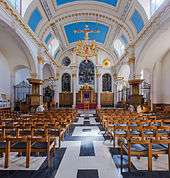
Archaeological evidence indicates that a church existed on this site in Saxon times. A medieval version of the church had been destroyed by the London Tornado of 1091, one of the earliest recorded (and one of the most violent) tornadoes in Britain, although the newly completed arched crypt survived.[12] During the later Norman period the church, known as “St Mary de Arcubus”,[13][14] was rebuilt and was famed for the arches (“bows”) of stone. At that period the 12 feet 6 inches (3.8 m) high vaulted crypt—although only accessible from within the church—had windows and buttresses visible from the street. However, the anecdotalist and historian John Stow wrongly attributes the name to 1515–16, when a crown steeple made of Caen stone in the form of arches supporting a lantern, was completed.[12] This is the form of the steeple in the Agas woodcut of 1561 (right). This erroneous explanation for the source of the name gained some traction in the centuries to follow, including an endorsement by Palace of Westminster architect Augustus Pugin.[15][16][17]
From at least the 13th century, the church was a peculier of the Diocese of Canterbury and the seat of the Anglican ecclesiastical court, the Court of Arches, to which it gave the name.[18][12] The “bow bells”, which could be heard as far away as Hackney Marshes,[19] were once used to order a curfew in the City of London.[12] This building burned in the Great Fire of London of 1666 (whereupon the Court of Arches transferred sittings to the nearby Doctors' Commons).[12]
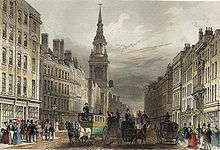
The church with its steeple had been a landmark of London. Considered the second most important church in the City of London after St Paul's Cathedral, St-Mary-le-Bow was one of the first churches to be rebuilt after the fire by Christopher Wren and his office.[20] The current structure was built to the designs of Wren between 1671 and 1673; the 223-foot (68 m) steeple was completed in 1680. The mason-contractor was Thomas Cartwright,[21] one of the leading London mason-contractors and carvers of his generation.
In 1914, a stone from the crypt of St Mary-le-Bow church was placed in Trinity Church, New York, in commemoration of the fact that King William III granted the vestry of Trinity Church the same privileges as St Mary-le-Bow vestry, the forerunner of lower-tier local government. Since the early 1940s, a recording of the Bow Bells made in 1926 has been used by the BBC World Service as an interval signal for the English-language broadcasts. It is still used today preceding some English-language broadcasts.
Much of the current building was destroyed by a German bomb during the Blitz on 10 May 1941,[22] during which fire the bells crashed to the ground. Restoration under the direction of Laurence King[23] began in 1956 (with internal fittings by Faith-Craft, part of the Society of the Faith). The bells as listed above, cast in 1956, were eventually installed to resume ringing in 1961. The church was formally reconsecrated in 1964, having achieved designation as a Grade I listed building on 4 January 1950.[1][24]
In the church is a memorial to members of the Norwegian resistance who died in the Second World War, which is in two parts; a commemorative plaque and a relief of Saint George and the Dragon by Ragnhild Butenschøn.
In the churchyard is a statue of Captain John Smith of Jamestown, founder of Virginia and former parishioner of the church.
Since 1989, there has been a restaurant in the crypt: Café Below.[25]
Services today
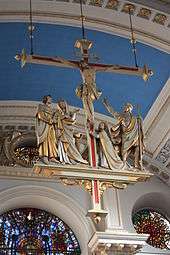
St Mary-le-Bow ministers to the financial industry and livery companies of the City of London.[26] Consequently, services feature weekday morning and evening led prayers lasting just a quarter of an hour generally at 08:15 (except Tuesdays) and 17:45.[27] There is a memorial in the church to the first Governor in Australia, Admiral Arthur Phillip, who was born in the parish. Through this connection the Rector of St Mary-le-Bow is the Chaplain of the Britain–Australia Society.
It is still home to the Court of Arches today.
Organ

The organ is a two-manual and pedal design by Kenneth Tickell and Company, with design and construction initiated in 2004. It occupies the case of the previous Rushworth and Dreaper organ (from the 1960s). The inaugural recital was given by Thomas Trotter in September 2010. The resident organist is Alan Wilson.
Image gallery
 West door
West door The crypt chapel
The crypt chapel
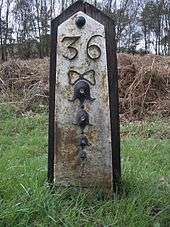 "Bow Bells" milepost on the London to Lewes road
"Bow Bells" milepost on the London to Lewes road- Statue of Captain John Smith in the churchyard
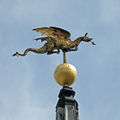 The dragon weathervane at the very top of the church
The dragon weathervane at the very top of the church
See also
- List of churches and cathedrals of London
- List of Christopher Wren churches in London
References
- Historic England. "Church of St Mary-le-Bow (Grade I) (1064696)". National Heritage List for England. Retrieved 17 December 2014.
- Mentioned in Pepys's diary, "Samuel Pepys – The Shorter Pepys" Latham, R. (Ed) p484: Harmondsworth, 1985 ISBN 0-14-009418-0
- Leigh's map of the Environs of London 1819 The city as was is shown in the map; it shows Bow, the village between Mile End and Stratford, in a historical form Stratford le Bow.
- "The City Churches" Tabor, M. p90:London; The Swarthmore Press Ltd; 1917
- The bells that made cockneys Howse, Christopher, Daily Telegraph 2007-09-22, accessed 30 October 2007
- Walters, Henry (1912). "St Mary-Le-Bow, London". Church Bells of England. Oxford University Press. p. 108. OCLC 20238862.
- So named in the famous Oranges and Lemons nursery rhyme.
- "Bells and bell-ringing". The Musical World. 12 (131): 23. 13 September 1838.
- Nicholl, Charles (1992). The reckoning : the murder of Christopher Marlowe. New York: Harcourt Brace. p. 242. ISBN 9780151759811.
- Hissey, James J. (1910). The charm of the road. London: Macmillan. p. 58. OCLC 5071681.
- Historic England. "Bow Bell Milestone 35 miles from London (1252622)". National Heritage List for England. Retrieved 9 July 2015.
- Keane, D. J.; Harding, Vanessa (1987). "St. Mary le Bow". Historical gazetteer of London before the Great Fire. Online edition from "British History Online". pp. 199–212. Retrieved 16 January 2009.
- Arcubus translates as "with bows"; see arcus and "The fourth declension" (PDF). The Latin Library. Retrieved 28 June 2016.
- Laura, Wright (2010). "A Pilot Study on the Singular Definite Articles le and la in Fifteenth-Century London". In Ingham, Richard (ed.). The Anglo-Norman language and its contexts. Woodbridge, Suffolk, UK: York Medieval Press. p. 137. ISBN 9781903153307.
- Bailey, Nathan (1734). The antiquities of London and Westminster. London: Osborn. OCLC 67577721.
- "St Mary Bow". The Month and Catholic Review. 24: 390. May 1875.
- Britton, John; Pugin, Augustus (1828). "The Church of St.-Mary-le-Bow, Cheapside". Illustrations of the Public Buildings of London: With Historical and ... London. p. 135. OCLC 4007910.
after James Peller Malcolm
- Catholic Encyclopaedia, 1907 edition
- "London noise 'mutes Bow Bells to endanger Cockneys'". BBC News. Retrieved 22 June 2016.
- The City Churches of Sir Christopher Wren, Jeffery, P., Continuum International Publishing Group Ltd, 2007 ISBN 978-1-84725-014-8
- London: the City Churches, Pevsner, N. / Bradley, S. New Haven, Yale, 1998 ISBN 0-300-09655-0
- "The London Encyclopaedia" Hibbert, C; Weinreb, D; Keay, J: London, Pan Macmillan, 1983 (rev 1993,2008) ISBN 978-1-4050-4924-5
- "The Visitor's Guide to the City of London Churches" Tucker, T: London, Friends of the City Churches, 2006, ISBN 0-9553945-0-3
- Historic England. "Details from listed building database (1064696)". National Heritage List for England. Retrieved 22 January 2009.
- "Café Below – fresh, seasonal breakfast & lunch in the city of London". Café Below – fresh, seasonal breakfast & lunch in the city of London.
- Church's historic home in the City Byrne, Michael and Bush, G.R. Times Online 26 October 2007, accessed 30 October 2007
- "St Mary-le-Bow Cheapside - A Church Near You". www.achurchnearyou.com.
Further reading
- Howard Colvin, Biographical Dictionary of British Architects
- Michael Byrne and George R. Bush (eds), St Mary-le-Bow: A History (Privately published, 2007).
External links
| Wikimedia Commons has media related to St Mary-le-Bow. |